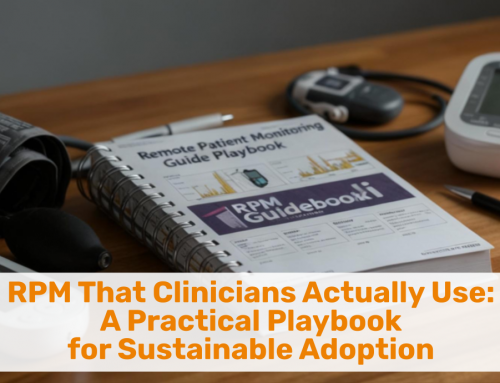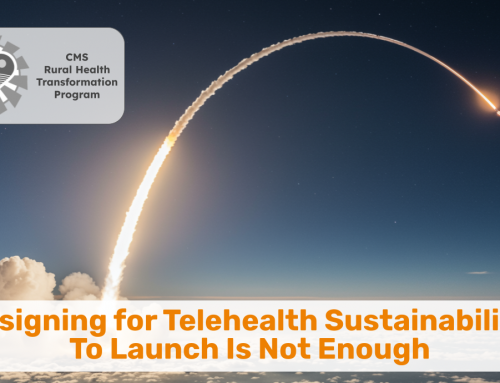Since the beginning of the year — after Chris Adamec’s great talk at the January 2025 Telehealth T-Time — I’ve been debunking common myths that politicians and other healthcare non-experts may hold. I questioned whether Telehealth really drives up cost, pondered whether virtual care is truly less valuable, and imagined what a conversation with a Telehealth Denier would go like.
This time, I’m tackling the hand-wringing fear that telehealth is on a path to wipe out brick-and-mortar clinics, that digital visits will somehow hollow out community care, especially in rural areas, until nothing is left but an app and a chatbot.
So let’s cut right through it: Telehealth isn’t killing clinics.
But the refusal to offer it? That just might.
First, Let’s Get the Definitions Straight
It’s impossible to have a serious conversation about this without making one essential distinction: virtual-only telehealth versus integrated telehealth or hybrid care.
While up until Covid telehealth was mostly embraced by academic medical centers and forward thinking health systems, the pandemic pushed everyone into the telehealth pool and it was sink or swim. Many sank to the bottom and only practiced telephonic “telehealth” while a few (who had been dipping their toes in telehealth prior to March 2020) were able to stay afloat.
So in May 2020 I penned my first article on the concept of Hybrid Care: The Best of Both Worlds, which I updated in 2021 (adding the concept of “block cheese scheduling”).
Virtual-only telehealth companies exist, yes. They’re growing. They’re offering 24/7 visits, sometimes asynchronous care, but mostly only with a limited scope, skimming the cream off of the top. They’re financed by private equity and venture capital and are designed for scale, convenience, and profit.
But they are not the majority of telehealth in use today.
The vast majority of telehealth services — especially those covered by public and commercial payers — are offered by traditional clinics, hospitals, and health systems that have integrated virtual visits into their operations. This is integrated care, and it’s fundamentally different. It’s a clinician clicking into a visit with a patient they already know. It’s a physical therapist doing a follow-up with someone recovering at home. It’s a psychiatrist checking in from one town over instead of three states away.
So no — telehealth isn’t erasing clinics. It’s expanding their reach. It’s giving them the flexibility to meet patients where they are while maintaining continuity, quality, and trust.
The Clinics That Don’t Offer Telehealth? They’re Losing — Fast.
Here’s a reality check: clinics that haven’t adopted telehealth aren’t being “preserved.” They’re bleeding revenue.
Every day, they deal with no-shows, late cancellations, patients who say “I just couldn’t make it in.” That’s money lost, care missed, follow-up delayed. And it’s entirely preventable.
Clinics offering telehealth can flip those missed appointments into completed visits. They can backfill open slots. They can increase their schedule density without burning out providers. And they can do it without lowering their clinical standards — because good telehealth isn’t cutting corners. It’s cutting friction.
And then there’s the other loss — the long game. The patients who leave.
Because let’s be honest: once a patient experiences a seamless, on-demand, competent virtual visit, they don’t want to go back to waiting three weeks for an appointment; they have to take half a day off work to attend. If your clinic can’t offer that flexibility, another one will.
And increasingly, it won’t just be a clinic. It will be a retail health platform. A national telehealth provider. A virtual-first insurance plan.
And once your patients get comfortable with that model? They’re gone.
“But What About Rural Access?”
Ah yes, the rural paradox. The idea that virtual care is somehow harming access in rural communities — where clinics are supposedly at risk of being shut down by digital competition.
Let’s be clear: most rural communities aren’t exactly overrun with healthcare options. Patients are already driving 45 minutes, sometimes hours, for basic care. Workforce shortages are chronic. Primary care deserts are real.
So no, telehealth isn’t taking access away from these areas. In most cases, it’s the only thing adding to it.
Telehealth allows rural clinics to:
-
Tap into (virtual) specialists they couldn’t otherwise attract — Offer behavioral health services their town desperately needs
-
Check in on post-op patients without making them drive
-
Retain patients who might otherwise leave the system entirely
Far from being a threat, virtual care is often the only thing keeping rural clinics relevant.
And by the way — there’s nothing about telehealth that requires abandoning the physical. It’s not about closing doors. It’s about opening more of them.
Competition Isn’t the Enemy — Stagnation Is
At the heart of this myth is a quiet fear that’s been building for years: that traditional healthcare organizations are being outpaced.
And yes — some are. But that’s not telehealth’s fault.
We don’t protect outdated business models in healthcare just because they’ve been around a while. That’s not how innovation — or access — works. America doesn’t limit competition to protect incumbents. We encourage it — and we expect providers to adapt.
If your clinic is losing patients to a virtual-only startup, the answer cannot be to try and regulate them out of existence. The answer is to compete better. Offer more. Build smarter workflows. Rethink how care gets delivered.
That’s not a threat to your clinic — it’s your blueprint for survival.



It’s Not Virtual or In-Person. It’s Both.
Here’s what the most effective care models have figured out: telehealth isn’t a replacement — it’s a clinical tool.
Patients still need hands-on care. Physical exams. Imaging. Lab draws. Surgery. No one’s pretending otherwise.
But so much of what clogs up the system and wastes patients’ time — routine follow-ups, medication management, mental health check-ins, care coordination — can be done virtually. And when it is? Everyone benefits.
Clinicians gain time (less small talk, digital intake). Patients gain access. Systems gain efficiency (and revenue). It’s not either/or. It’s and.
And the real winners are those who build a system where those pieces flow together — where the virtual handoff to in-person (and back again) is seamless, documented, and clinically sound.
That’s not disruption. That’s evolution.
So — Is Telehealth a Clinic Killer?
No. But it is a clinic challenger. And for those unwilling to adapt, it’s a reality check that’s long overdue.
Telehealth is not here to replace care. It’s here to transform access to it. And the clinics that understand that — clinics that integrate virtual visits into their workflows, that embrace hybrid care models, that reimagine how they engage their patients — are not only surviving.
They’re thriving.
Because in healthcare, just like everywhere else, it’s not the strongest that survive. It’s the most adaptable.
Your Virtual Move!
If you’re still treating telehealth like a side project, a stopgap, or a passing trend — it’s time to rethink.
Start by looking at your practice schedule. How many visits last week could have been handled virtually? How many were missed altogether? What would your revenue and patient satisfaction look like if you captured even half of those?
Telehealth isn’t the problem. It’s a proven part of the solution. But only if it’s fully integrated. Only if it’s embraced — not tolerated.
The future is hybrid. The only question left is whether your clinic will be part of it.








To receive articles like these in your Inbox every week, you can subscribe to Christian’s Telehealth Tuesday Newsletter.
Christian Milaster and his team optimize Telehealth Services for health systems and physician practices. Christian is the Founder and President of Ingenium Digital Health Advisors where he and his expert consortium partner with healthcare leaders to enable the delivery of extraordinary care.
Contact Christian by phone or text at 657-464-3648, via email, or video chat.






